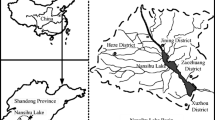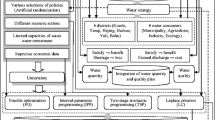Abstract
To alleviate the water resources shortage in arid or semi-arid area, various water transfer projects have been constructed and put into operation over the last few decades. Apart from the available water, the allocation scheme also determines whether the water demands alongside can be satisfied well. Different from traditional evaluation without considering how often the failure occurs and how severe magnitude the failure may be when operating a scheme, this study proposes three indexes to evaluate scheme performance comprehensively, which are: (1) the satisfaction degree of a selected scheme (reliability); (2) the ability of the system to recover from a failure to satisfactory state (stability); and (3) the maximum damage of operating a scheme (severity). To illustrate the application of these evaluation indexes, an optimization model and an exponent describing differences among schemes are established, and then applied to the east route South-to-North Water Transfer project in China. The result shows that there exist tradeoffs among scheme’s benefits, which is described by reliability, stability, and severity. And with the increase of the exponent, the optimal scheme would consider deficit distribution more. In order to make the water transfer system with high reliability, high stability, and low severity, the exponent should be in the range of 1.0–2.0. These findings can be taken as the references to the operation of the water transfer projects.









Similar content being viewed by others
References
Afshar MH (2012) Large scale reservoir operation by constrained particle swarm optimization algorithms. J Hydro Environ Res 6(1):75–87
Barnes GW, Chung FI (1986) Operational planning for California water-system. J Water Resour Plan Manag-ASCE 112(1):71–86
Chen L, Chang FJ (2007) Applying a real-coded multi-population genetic algorithm to multi-reservoir operation. Hydrol Process 21(5):688–698
Cohon JL (1978) Multiobjective programming and planning. Academic Press, New York
Guo XN, Hu TS et al (2012) Bilevel model for multi-reservoir operating policy in inter-basin water transfer-supply project. J Hydrol 424:252–263
Gupta J, van der Zaag P (2008) Interbasin water transfers and integrated water resources management: where engineering, science and politics interlock. Phys Chem Earth 33(1–2):28–40
Hashimoto T, Stedinger JR et al (1982) Reliability, resiliency, and vulnerability criteria for water-resource system performance evaluation. Water Resour Res 18(1):14–20
Jothiprakash V, Arunkumar R (2014) Multi-reservoir optimization for hydropower production using NLP technique. KSCE J Civ Eng 18(1):344–354
Li FF, Shoemaker CA et al (2013) Estimating maximal annual energy given heterogeneous hydropower generating units with application to the three gorges system. J Water Resour Plan Manag-ASCE 139(3):265–276
Li FF, Shoemaker CA et al (2015) Hierarchical multi-reservoir optimization modeling for real-world complexity with application to the three gorges system. Environ Model Softw 69:319–329
Lingo (2017) http://www.lindo.com/.
Louati MH, Benabdallah S et al (2011) Application of a genetic algorithm for the optimization of a complex reservoir system in Tunisia. Water Resour Manag 25(10):2387–2404
Mahjouri N, Ardestani M (2010) A game theoretic approach for interbasin water resources allocation considering the water quality issues. Environ Monit Assess 167(1–4):527–544
Moeini R, Afshar MH (2009) Application of an ant colony optimization algorithm for optimal operation of reservoirs: a comparative study of three proposed formulations. Sci Iranica Trans a-Civil Eng 16(4):273–285
Nikoo MR, Kerachian R et al (2012) An interval parameter model for cooperative inter-basin water resources allocation considering the water quality issues. Water Resour Manag 26(11):3329–3343
Oliveira R, Loucks DP (1997) Operating rules for multireservoir systems. Water Resour Res 33(4):839–852
Qin KL (2016) Optimal water resources regulation for jiangsu section of south-to-north water diversion east route project based on dynamic programming. Dissertation, China Agriculture University
Reis LFR, Walters GA et al (2005) Multi-reservoir operation planning using hybrid genetic algorithm and linear programming (GA-LP): an alternative stochastic approach. Water Resour Manag 19(6):831–848
Sabet MH, Coe JQ (1986) Models for water and power scheduling for the California-state-water-project. Water Resour Bull 22(4):587–596
Sadegh M, Mahjouri N et al (2010) Optimal inter-basin water allocation using crisp and fuzzy shapley games. Water Resour Manag 24(10):2291–2310
Sharma V, Jha R et al (2004) Optimal multi-reservoir network control by two-phase neural network. Electr Power Syst Res 68(3):221–228
Takeuchi K, Moreau DH (1974) Optimal control of multiunit interbasin water-resource systems. Water Resour Res 10(3):407–414
Wang Q, Zhou HC et al (2015) Optimal operation of bidirectional inter-basin water transfer-supply system. Water Resour Manag 29(9):3037–3054
Yurtal R, Seckin G et al (2005) Hydropower optimization for the lower Seyhan system in Turkey using dynamic programming. Water Int 30(4):522–529
Zhang P, Zhao M, Zheng CY (2006) Optimal allocation of water resources in the water import areas of the east route of the south-to-north water transfer region. J Econ Water Resour 28(5):88–94
Acknowledgements
This research was supported by National Natural Science Foundation of China (Grant No.51409248), and Open Research Fund Program of State key Laboratory of Hydroscience and Engineering.
Author information
Authors and Affiliations
Corresponding authors
Rights and permissions
About this article
Cite this article
Li, XY., Li, FF. & Qiu, J. A New Evaluation for Water Transfer Optimal Schemes with the Consideration of Reliability, Stability, and Severity. Water Resour Manage 31, 2823–2836 (2017). https://doi.org/10.1007/s11269-017-1665-y
Received:
Accepted:
Published:
Issue Date:
DOI: https://doi.org/10.1007/s11269-017-1665-y




